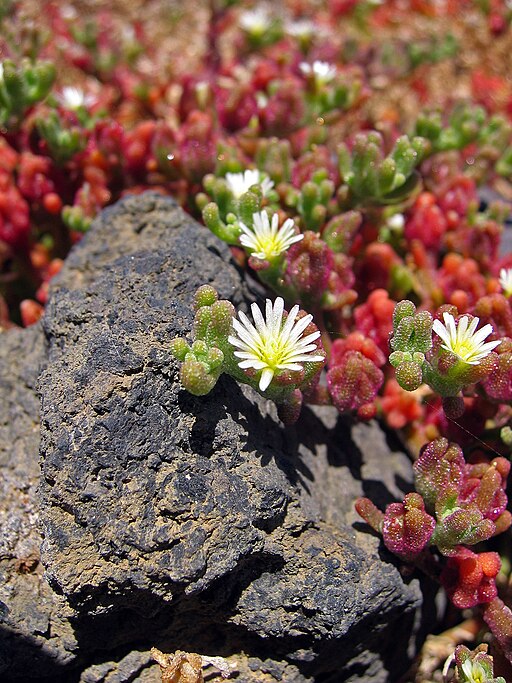
Classification System: APG IV
Superregnum: Eukaryota
Regnum: Plantae
Cladus: Angiosperms
Cladus: Eudicots
Cladus: Core eudicots
Ordo: Caryophyllales
Familia: Aizoaceae
Subfamilia: Mesembryanthemoideae
Genus: Mesembryanthemum
Subgenus: M. subg. Mesembryanthemum
Sectio: M. sect. Mesembryanthemum
Species: Mesembryanthemum nodiflorum
Name
Mesembryanthemum nodiflorum L., 1753
Synonyms
Cryophytum cleistum L. Bol.
Cryophytum gibbosum N. E. Br.
Cryophytum nodiflorum (L.) Bolus
Cryophytum rogersii L. Bol.
Gasoul nodiflorum (L.) Rothm.
Mesembryanthemum caducum Aiton
Mesembryanthemum copticum L.
Mesembryanthemum inornatum L. Bol.
Mesembryanthemum paucandrum L. Bol.
Psilocaulon caducum (Aiton) N.E.Br.
Stigmatocarpon caducum (Ait.) L. Bol.
Stigmatocarpum copticum L. Bol.
Distribution
Native distribution areas:
Continental: Europe
Portugal, Spain, Gibraltar, Baleares, France, Corsica, Sardinia, Malta, Sicily, Italy, Croatia, Greece (incl. Kiklades), Crete, East Aegaean Isl., Rhodos
Continental: Africa
Libya, Tunisia, Algeria, Morocco, SW-Namibia, South Africa (N-Cape Prov., W-Cape Prov.), Western Sahara
Continental: Asie
Turkey (SSW-Anatolia), Bahrain, Cyprus (E-Cyprus, N-Cyprus, S-Cyprus, W-Cyprus), Egypt (Nile Delta, NW-coastal Egypt), Iran (S-Iran, W-Iran), Iraq (SE-Iraq: Mesopotamia, S-Iraq), Israel (C-Israel, coastal W-Israel, Rift Valley, N-Israel, N-Negev Desert, Judean Desert), Jordania (E-Jordania, S-Jordania), Kuwait, Lebanon (coastal W-Lebanon), Saudi Arabia (NE-Saudi Arabia, Asir), Sinai peninsula (N-Sinai, S-Sinai), Syria (C-Syrian Desert), United Arab Emirates, Oman, Qatar, Pakistan (Baluchistan)
References: Brummitt, R.K. 2001. TDWG – World Geographical Scheme for Recording Plant Distributions, 2nd Edition
References
Linnaeus, C. 1753. Species Plantarum. Tomus I: 480. Reference page.
Links
Hassler, M. 2018. Mesembryanthemum nodiflorum. World Plants: Synonymic Checklists of the Vascular Plants of the World In: Roskovh, Y., Abucay, L., Orrell, T., Nicolson, D., Bailly, N., Kirk, P., Bourgoin, T., DeWalt, R.E., Decock, W., De Wever, A., Nieukerken, E. van, Zarucchi, J. & Penev, L., eds. 2018. Species 2000 & ITIS Catalogue of Life. Published online. Accessed: 2018 Jul. 11. Reference page.
International Plant Names Index. 2018. Mesembryanthemum nodiflorum. Published online. Accessed: Jul. 11 2018.
The Plant List 2013. Mesembryanthemum nodiflorum in The Plant List Version 1.1. Published online. Accessed: 2018 Jul. 11.
Tropicos.org 2018. Mesembryanthemum nodiflorum. Missouri Botanical Garden. Published online. Accessed: 11 Jul. 2018.
USDA, ARS, Germplasm Resources Information Network. Mesembryanthemum nodiflorum in the Germplasm Resources Information Network (GRIN), U.S. Department of Agriculture Agricultural Research Service. Accessed: 08-Apr-12.
Swedish Museum of Natural History, only in Swedish
Vernacular names
Deutsch: Knotenblütige Mittagsblume
español: Bastoncil
suomi: Keskipäivänkukka
svenska: Gul isört
Mesembryanthemum nodiflorum is a species of succulent plant in the genus Mesembryanthemum known by the common name slenderleaf iceplant. It is the type species for the genus. It is native to coastal areas of the Mediterranean Basin, Macaronesia, and Middle East[1] but it is known in many other places as an introduced species and sometimes an invasive weed, including several regions of Australia, parts of the western United States and adjacent Mexico, and some Atlantic islands.
M. nodiflorum is a usually annual herb forming a mostly prostrate clump or mat of stems up to a maximum of about 20 centimeters in length. The small stem branches are lined with knob-like cylindrical fleshy leaves up to 2 centimeters long. The herbage is green to bright red and visibly bumpy with shiny, bubble-like papillae. Flowers are solitary or borne in loose clusters. Each is about half a centimeter wide with many narrow to thready white or pale yellow petals. The fruit is a capsule which opens when it becomes wet, releasing seeds.
References
"M. nodiflorum" (PDF). Flora Iberica. Retrieved 12 July 2021.
Retrieved from "http://en.wikipedia.org/"
All text is available under the terms of the GNU Free Documentation License


